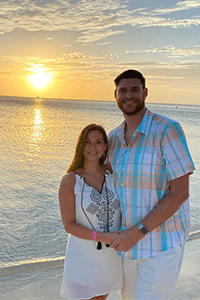John’s Journey to the UPMC Center for Aortic Disease
In May 2021, John and his family went ziplining to celebrate his daughter’s birthday.
“I remember that I hit my legs pretty hard off the landing deck,” says John. “They were sore for about two weeks before I decided to see a doctor.”
When John arrived at the doctor’s office, he was convinced that he strained a muscle in his calves. The team performed a scan on John’s legs and noticed bilateral popliteal aneurysms, one on each leg.
A popliteal aneurysm is an abnormal bulge or ballooning in the wall of the popliteal artery, located behind the knee joint. Most aneurysms are asymptomatic. However, if left untreated, aneurysms can rupture and cause internal bleeding or blood clots. Depending on where the aneurysm is located, a rupture or clot can be life-threatening.
Vascular Surgery
John’s wife, a UPMC nurse for more than 15 years, helped search for the right expert for John’s next stage of care. They connected with Rabih Chaer, MD, chief of the Division of Vascular Surgery and co-director of the UPMC Heart and Vascular Institute.
“The first visit I had with Dr. Chaer was amazing,” says John. “He answered all of the questions that I had and was really informative.”
Dr. Chaer performed popliteal stenting, a minimally invasive procedure that seals off the dilated aneurysm. This prevents blood from entering into the aneurysm.
“At my follow up appointment, Dr. Chaer asked if I had ever undergone genetic testing for Marfan syndrome,” says John. “I’m 6’7” with a seven-foot wingspan, so I knew that the chances of having this were strong. Since it’s a genetic disorder, I decided to go through with genetic testing, mainly for my two daughters. He referred me to the Adult Congenital Heart Disease Center to undergo testing.”
Congenital Heart Care
John’s results revealed that he tested positive for Marfan syndrome, a genetic disorder that affects the body’s connective tissue. A common complication of Marfan syndrome is heart disease, including aortic aneurysms and problems with heart valves. Patients with Marfan syndrome require lifelong surveillance by a heart disease specialist to identify and treat heart complications early.
To care for patients with cases like John’s, experts from specialties across the UPMC Heart and Vascular Institute established the UPMC Center for Aortic Disease. Their multidisciplinary care model ensures that patients with aortic disease receive the full scope of care – from vascular surgery to congenital heart care to cardiac surgery. The team’s close collaboration on cases, like John’s, ensures that a patient’s journey to each specialist is seamless.
Arvind Hoskoppal, MD, director of the UPMC Adult Congenital Heart Disease Center, ordered several tests to evaluate John’s heart health. The tests revealed that John had an ascending aortic aneurysm, a bulge in the portion of the aorta closest to the heart. Dr. Hoskoppal referred John to Ibrahim Sultan, MD, chief of the Division of Cardiac Surgery and co-director of the UPMC Heart and Vascular Institute, to be treated with cardiac surgery.
Cardiac Surgery
“Throughout all of the evaluations and diagnoses, my wife was such a huge help in coordinating my appointments, doing the research, and ensuring I saw the specialists I needed,” says John. “When we saw Dr. Sultan, he informed us that the only treatment for my aortic aneurysm was open heart surgery. We were shocked – I was receiving treatment for non-Hodgkin's lymphoma at the time and didn’t expect to undergo heart surgery.”
Drs. Sultan, Hoskoppal, and Chaer met with John’s oncologist to create a treatment plan that would address John’s unique needs. The team at the UPMC Center for Aortic Disease continuously worked together to discuss John’s case and determine the best care for him.
“This chain of care – it felt like a team was working with me,” says John. “They were always aware of what everyone else was doing. Throughout the meetings with different specialists, the MyUPMC app was tremendously helpful in communicating about my test results or my next appointment.”
In March 2022, John underwent open heart surgery with Dr. Sultan for a valve sparing aortic root replacement, ascending aorta and hemiarch replacement.
“The surgery went very smoothly,” says John. “I knew after talking with a coworker, who underwent the same procedure, that there would be a lot of fatigue after this surgery.”
Over the next year, John continued to build back his strength by walking as much as he could. He returned to work as a high school English teacher in fall 2022.
“After about a year, I finally started to feel like myself again,” says John. “I’ve started to notice that I have more energy than before the surgery.&rdquo
Now, John is back to his normal activities. He enjoys staying active by riding his bike and hiking with his kids. He continues to follow up with the team at the UPMC Center for Aortic Disease to monitor his health.
“My family decided to undergo genetic testing for Marfan syndrome,” says John. “My mother had it her entire life and never knew. One of my daughters also tested positive for the condition and sees Dr. Hoskoppal regularly to monitor her health. We truly trust Dr. Hoskoppal with our family’s care.”
John offers advice to anyone undergoing a similar experience.
“I would recommend that you trust in your care,” says John. “Always ask questions to your care team. They are so knowledgeable and explain things so clearly. It’s very easy to fall into a spiral of darkness with any unexpected medical diagnosis. I don’t let my medical conditions define me.”
John’s treatment and results may not be representative of all similar cases.

















